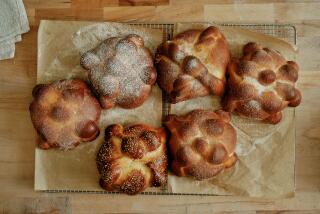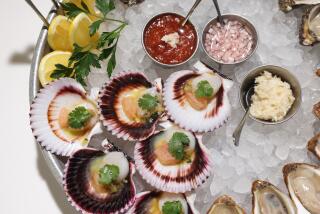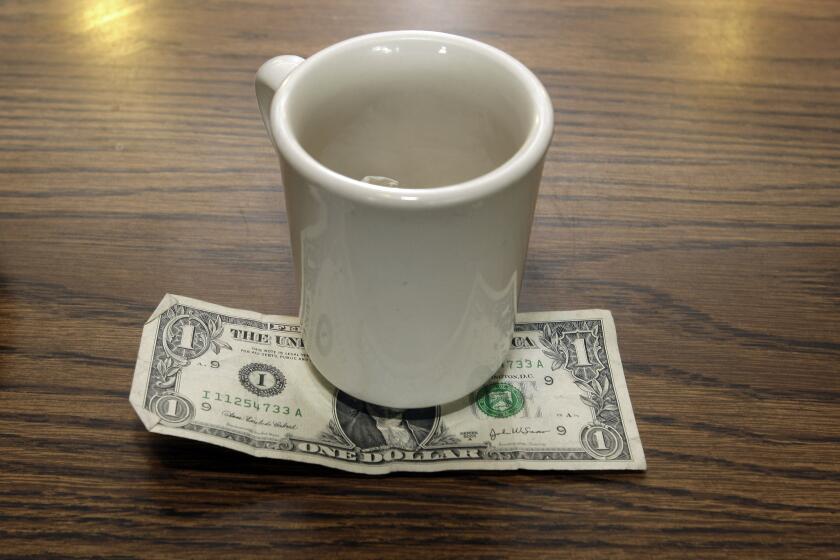Basque Food Is ‘Plain but Lusty’ : Cooking: International Folk Dance Festival performer Lynne Basterretche shares recipes from her Basque heritage.
- Share via
Every year about this time, Irwin Parnes, International Folk Dance Festival impresario, calls on us with a few names of dancers who cook.
After all, where else in Los Angeles would you learn about the cuisines of Cuica Calli Mexicans, Sevan Armenians, Krakusy Poles and Yatiri Incas?
Thanks to Parnes, we have featured recipes from Anatolia to Zimbabwe and beyond.
This year, Parnes came up with 16 year-old Lynne Basterretche, principal dancer of the Gauden Bat , a Basque dance troupe, to do the honors.
Basterretche brought not only samples from the Basque cuisine--typically Basque things such as veal braised in white wine and a beautifully caramelized flan called Coca in Basque, but also her mother and grandmother, a native of St. Esteben near Biarritz, on the Spanish frontier.
So before Basterretche steps into her costume for a few high kicks from a Basque Baso Dantsa (wine glass dance) that she will perform at the Los Angeles Music Center on March 9 in the 43rd International Folk Dance Festival (along with Sword twirling Armenians, Solidarity dancers from Poland, a Marshall Island flag drill, Blue Grass clogging, Philippine bamboo leaping and Egyptian belly dancing), there was a sniff of the braised veal, its fragrance wafting in the air of The Times’ photo studio.
Basterretche, who has been dancing for eight years and travels widely in the United States with her dance troupe, deferred to Catherine Petrissans, her grandmother, when it came to the recipes.
“Basque cooking is plain but lusty,” explained Petrissans. “It isn’t Spanish, even though the country in the Pyrenees borders Spain.”
It’s uniquely Basque, much like the language and culture itself. (Linguists classify the Basque language as the only known representative of its own language family.)
The Basques, regarded by some as the mystery people of Europe, whose prehistoric origins in their homeland in the Pyrenees may date several thousand years before Indo-European invasions in 2000 BC, boast a cuisine that makes use of ingredients of the land--tomatoes, garlic, onions, green peppers and wine. The use of veal and lamb is preferred because the mountainous Basque country promotes shepherding as a major way of life.
There are few herbs and spices used in the Basque cuisine. Instead, the flavors of the chief ingredients are allowed to come through without embellishment. Thyme, parsley, bay leaf and chives, however, are the exceptions, according to Petrissans.
VEAU BRAISE AU SANI BON
2 pounds cubed veal shoulder
4 slices prosciutto, diced
1/2 onion, diced
2 cloves garlic, minced
2 tablespoons olive oil
1 cup dry white wine
8 mushrooms, sliced
Salt, pepper
2 tablespoons chopped parsley
Saute veal, prosciutto, onion and garlic in olive oil until golden. Add wine, mushrooms, salt and pepper to taste and parsley. Simmer over low heat 45 minutes or until meat is tender. Makes 6 to 8 servings.
COCA
(Basque Flan)
1 cup sugar
1/4 cup water
8 eggs
2 cups hot milk
2 cups whipping cream
1 teaspoon vanilla
2 tablespoons rum
Combine 1/2 cup sugar and water in 2-quart heat-proof mold. Bring to boil. Boil until syrup turns golden brown. Swirl pan to coat sides with syrup.
Beat eggs and add remaining 1/2 cup sugar. Gradually add hot milk and whipping cream. Stir in vanilla and rum, blending well. Strain and pour into caramelized mold.
Place mold in large baking pan. Fill halfway up sides of mold with water. Bake at 350 degrees 30 to 40 minutes. Allow to cool. Makes 6 to 8 servings.
More to Read
Eat your way across L.A.
Get our weekly Tasting Notes newsletter for reviews, news and more.
You may occasionally receive promotional content from the Los Angeles Times.










